CHEVROLET SUBURBAN 1999 8.G Owners Manual
Manufacturer: CHEVROLET, Model Year: 1999, Model line: SUBURBAN, Model: CHEVROLET SUBURBAN 1999 8.GPages: 424, PDF Size: 2.83 MB
Page 261 of 424

yellowblue
5-19
Engine Fan Noise
Your vehicle has a clutched engine cooling fan. When
the clutch is engaged, the fan spins faster to provide
more air to cool the engine. In most everyday driving
conditions, the fan is spinning slower and the clutch is
not fully engaged. This improves fuel economy and
reduces fan noise. Under heavy vehicle loading, trailer
towing and/or high outside temperatures, the fan speed
increases as the clutch more fully engages. So you may
hear an increase in fan noise. This is normal and should
not be mistaken as the transmission slipping or making
extra shifts. It is the cooling system functioning
properly. The fan will slow down when additional
cooling is not required and the clutch disengages.
You may also hear this fan noise when you start the
engine. It will go away as the fan clutch disengages.
If a Tire Goes Flat
It's unusual for a tire to ªblow outº while you're driving,
especially if you maintain your tires properly. If air goes
out of a tire, it's much more likely to leak out slowly.
But if you should ever have a ªblowout,º here are a few
tips about what to expect and what to do:
If a front tire fails, the flat tire will create a drag that
pulls the vehicle toward that side. Take your foot off the
accelerator pedal and grip the steering wheel firmly.
Steer to maintain lane position, and then gently brake to
a stop well out of the traffic lane.
A rear blowout, particularly on a curve, acts much like a
skid and may require the same correction you'd use in a
skid. In any rear blowout, remove your foot from the
accelerator pedal. Get the vehicle under control by
steering the way you want the vehicle to go. It may be
very bumpy and noisy, but you can still steer. Gently
brake to a stop
-- well off the road if possible.
If a tire goes flat, the next part shows how to use your
jacking equipment to change a flat tire safely.
Page 262 of 424
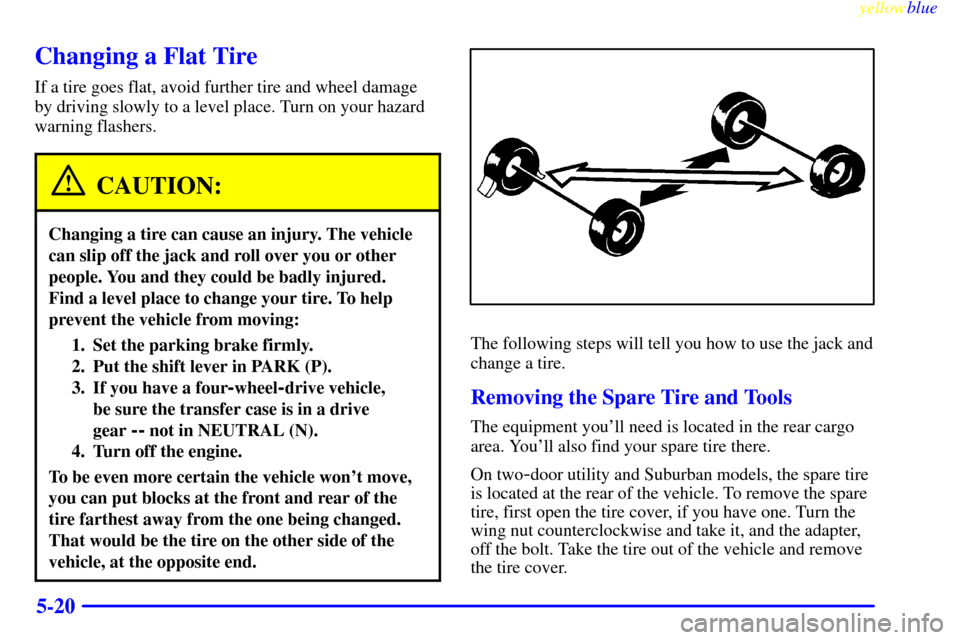
yellowblue
5-20
Changing a Flat Tire
If a tire goes flat, avoid further tire and wheel damage
by driving slowly to a level place. Turn on your hazard
warning flashers.
CAUTION:
Changing a tire can cause an injury. The vehicle
can slip off the jack and roll over you or other
people. You and they could be badly injured.
Find a level place to change your tire. To help
prevent the vehicle from moving:
1. Set the parking brake firmly.
2. Put the shift lever in PARK (P).
3. If you have a four
-wheel-drive vehicle,
be sure the transfer case is in a drive
gear
-- not in NEUTRAL (N).
4. Turn off the engine.
To be even more certain the vehicle won't move,
you can put blocks at the front and rear of the
tire farthest away from the one being changed.
That would be the tire on the other side of the
vehicle, at the opposite end.
The following steps will tell you how to use the jack and
change a tire.
Removing the Spare Tire and Tools
The equipment you'll need is located in the rear cargo
area. You'll also find your spare tire there.
On two
-door utility and Suburban models, the spare tire
is located at the rear of the vehicle. To remove the spare
tire, first open the tire cover, if you have one. Turn the
wing nut counterclockwise and take it, and the adapter,
off the bolt. Take the tire out of the vehicle and remove
the tire cover.
Page 263 of 424

yellowblue
5-21
On four-door utility models, the spare tire may be stored
under the vehicle in an underbody carrier.
4-Door Utility Models
A. Hoist Assembly
B. Hoist Shaft
C. Ratchet
D. Jack HandleE. Retainer
F. Valve Stem, Pointed
Down
G. Spare TireFollow these instructions to lower the spare tire:
1. One side of the ratchet has an UP marking. The other
side has a DOWN marking. Assemble the ratchet to
the hook near the end of the jack handle (as
illustrated) with the DOWN marking facing you.
Insert the other end through the hole in the rear
bumper and into the hoist shaft.
2. Turn the ratchet to lower the spare tire to the ground.
Continue to turn the ratchet until the spare tire can be
pulled out from under the vehicle.
3. When the tire has been lowered, tilt the retainer at
the end of the cable so it can be pulled up through
the wheel opening.
4. Put the spare tire near the flat tire.
Page 264 of 424
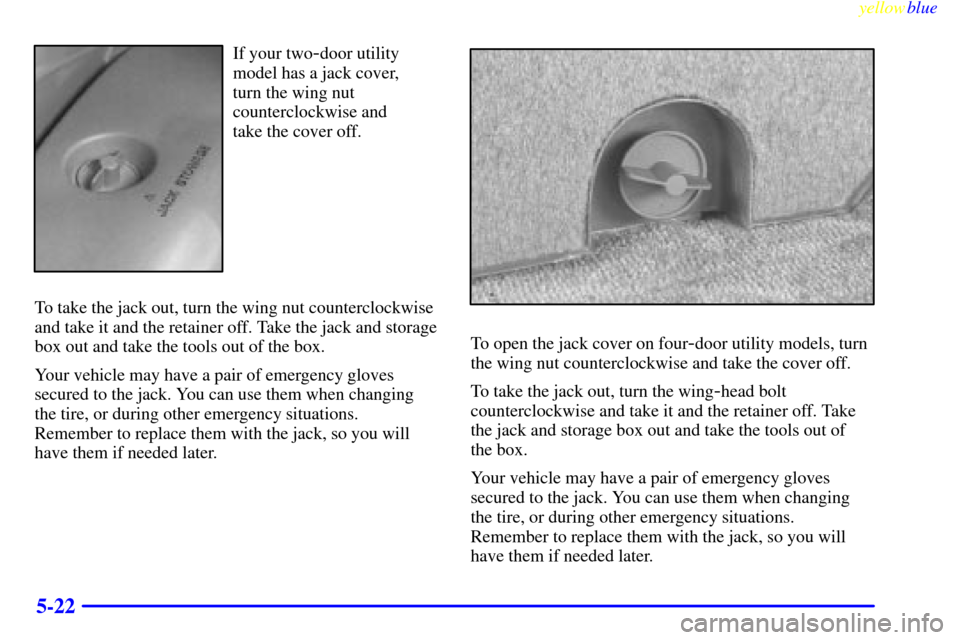
yellowblue
5-22
If your two-door utility
model has a jack cover,
turn the wing nut
counterclockwise and
take the cover off.
To take the jack out, turn the wing nut counterclockwise
and take it and the retainer off. Take the jack and storage
box out and take the tools out of the box.
Your vehicle may have a pair of emergency gloves
secured to the jack. You can use them when changing
the tire, or during other emergency situations.
Remember to replace them with the jack, so you will
have them if needed later.
To open the jack cover on four-door utility models, turn
the wing nut counterclockwise and take the cover off.
To take the jack out, turn the wing
-head bolt
counterclockwise and take it and the retainer off. Take
the jack and storage box out and take the tools out of
the box.
Your vehicle may have a pair of emergency gloves
secured to the jack. You can use them when changing
the tire, or during other emergency situations.
Remember to replace them with the jack, so you will
have them if needed later.
Page 265 of 424
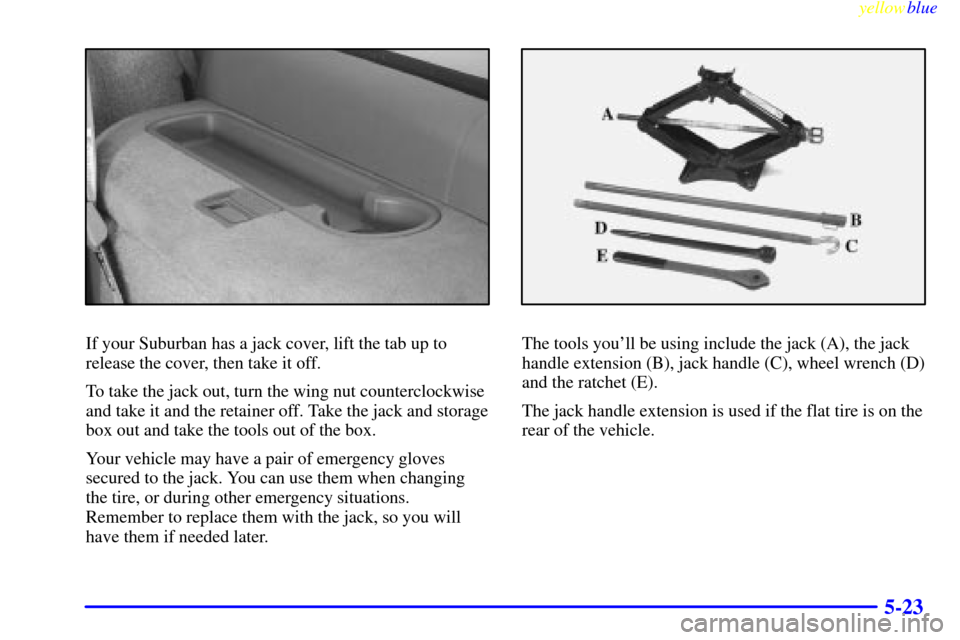
yellowblue
5-23
If your Suburban has a jack cover, lift the tab up to
release the cover, then take it off.
To take the jack out, turn the wing nut counterclockwise
and take it and the retainer off. Take the jack and storage
box out and take the tools out of the box.
Your vehicle may have a pair of emergency gloves
secured to the jack. You can use them when changing
the tire, or during other emergency situations.
Remember to replace them with the jack, so you will
have them if needed later.The tools you'll be using include the jack (A), the jack
handle extension (B), jack handle (C), wheel wrench (D)
and the ratchet (E).
The jack handle extension is used if the flat tire is on the
rear of the vehicle.
Page 266 of 424
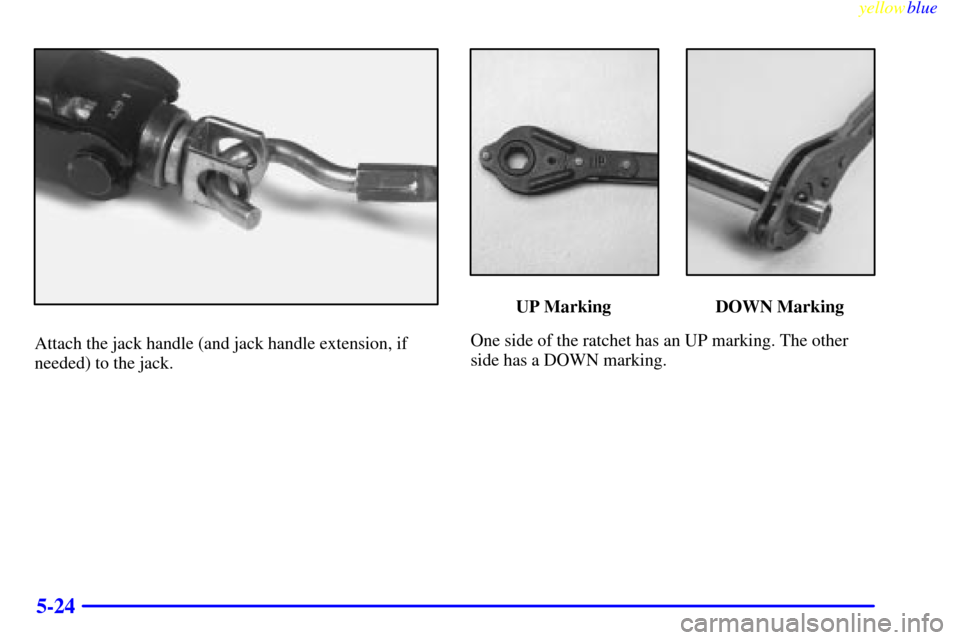
yellowblue
5-24
Attach the jack handle (and jack handle extension, if
needed) to the jack.
UP Marking DOWN Marking
One side of the ratchet has an UP marking. The other
side has a DOWN marking.
Page 267 of 424
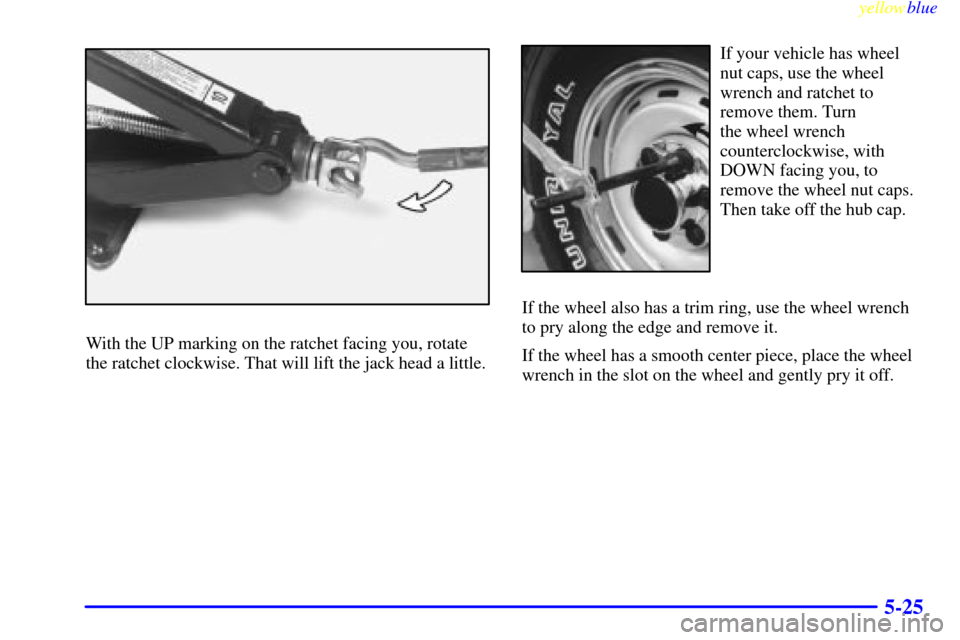
yellowblue
5-25
With the UP marking on the ratchet facing you, rotate
the ratchet clockwise. That will lift the jack head a little.
If your vehicle has wheel
nut caps, use the wheel
wrench and ratchet to
remove them. Turn
the wheel wrench
counterclockwise, with
DOWN facing you, to
remove the wheel nut caps.
Then take off the hub cap.
If the wheel also has a trim ring, use the wheel wrench
to pry along the edge and remove it.
If the wheel has a smooth center piece, place the wheel
wrench in the slot on the wheel and gently pry it off.
Page 268 of 424
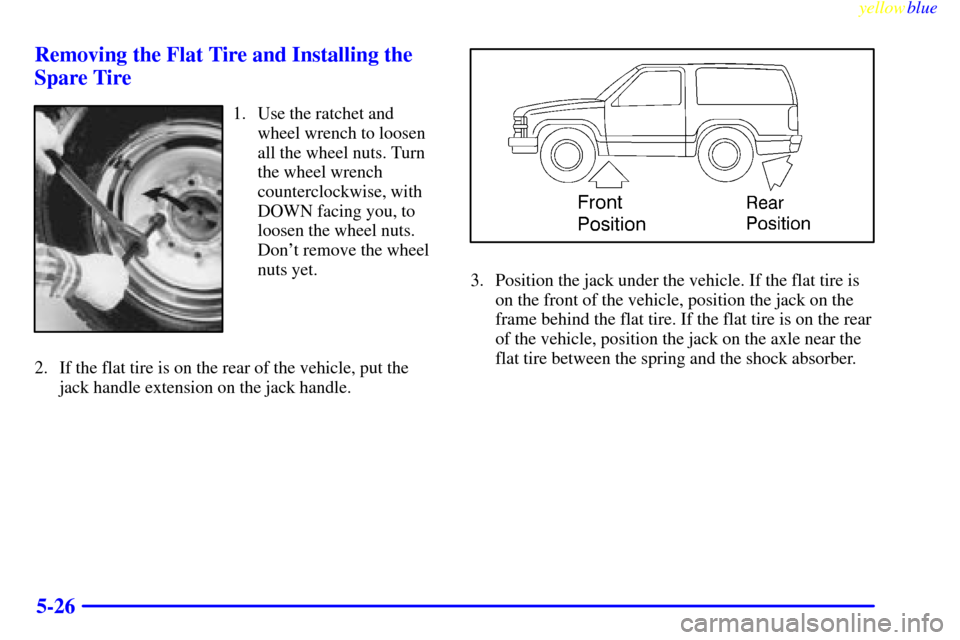
yellowblue
5-26 Removing the Flat Tire and Installing the
Spare Tire
1. Use the ratchet and
wheel wrench to loosen
all the wheel nuts. Turn
the wheel wrench
counterclockwise, with
DOWN facing you, to
loosen the wheel nuts.
Don't remove the wheel
nuts yet.
2. If the flat tire is on the rear of the vehicle, put the
jack handle extension on the jack handle.
3. Position the jack under the vehicle. If the flat tire is
on the front of the vehicle, position the jack on the
frame behind the flat tire. If the flat tire is on the rear
of the vehicle, position the jack on the axle near the
flat tire between the spring and the shock absorber.
Page 269 of 424
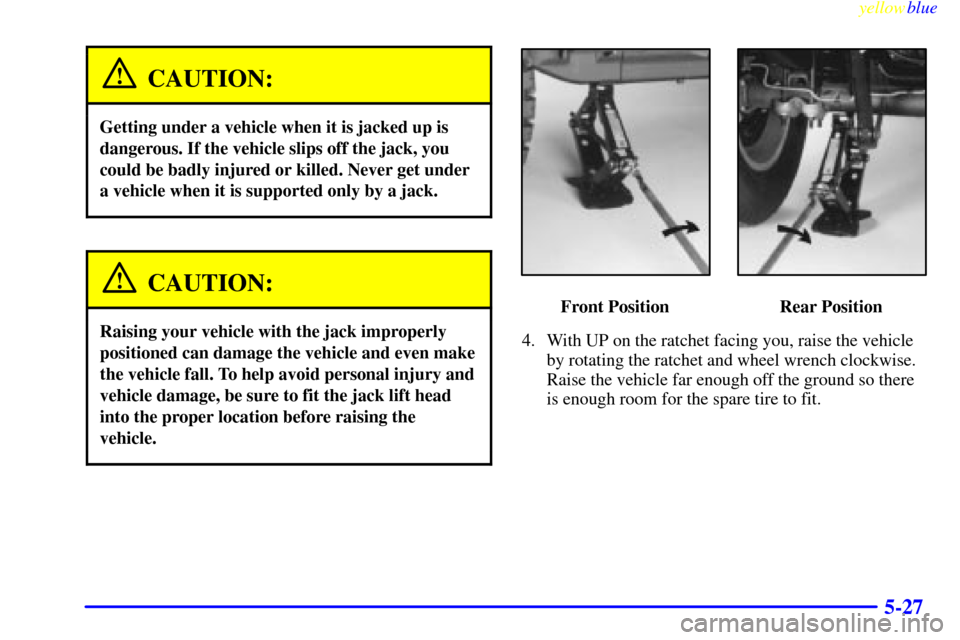
yellowblue
5-27
CAUTION:
Getting under a vehicle when it is jacked up is
dangerous. If the vehicle slips off the jack, you
could be badly injured or killed. Never get under
a vehicle when it is supported only by a jack.
CAUTION:
Raising your vehicle with the jack improperly
positioned can damage the vehicle and even make
the vehicle fall. To help avoid personal injury and
vehicle damage, be sure to fit the jack lift head
into the proper location before raising the
vehicle.
Front Position Rear Position
4. With UP on the ratchet facing you, raise the vehicle
by rotating the ratchet and wheel wrench clockwise.
Raise the vehicle far enough off the ground so there
is enough room for the spare tire to fit.
Page 270 of 424
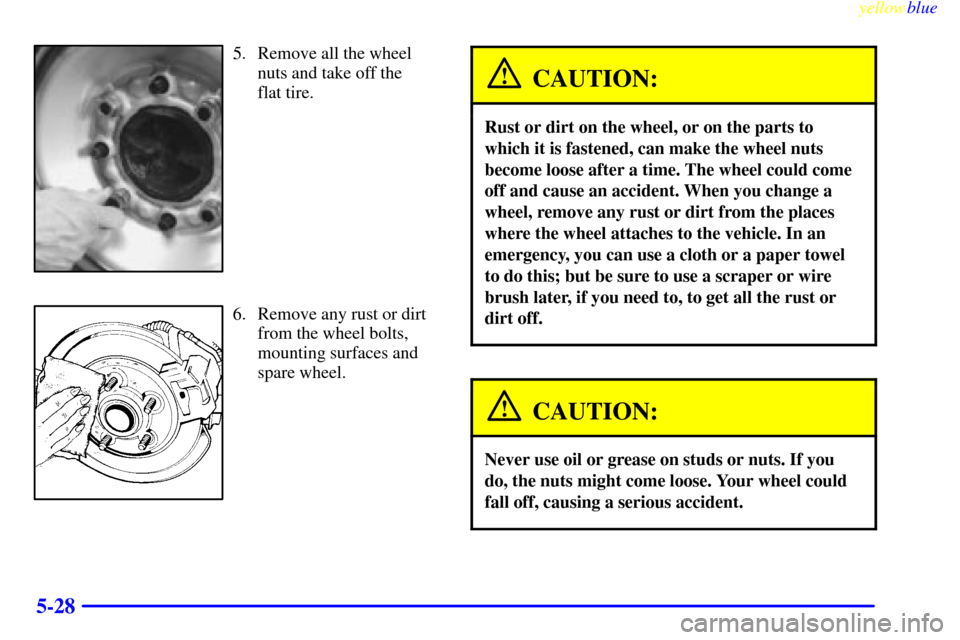
yellowblue
5-28
5. Remove all the wheel
nuts and take off the
flat tire.
6. Remove any rust or dirt
from the wheel bolts,
mounting surfaces and
spare wheel.
CAUTION:
Rust or dirt on the wheel, or on the parts to
which it is fastened, can make the wheel nuts
become loose after a time. The wheel could come
off and cause an accident. When you change a
wheel, remove any rust or dirt from the places
where the wheel attaches to the vehicle. In an
emergency, you can use a cloth or a paper towel
to do this; but be sure to use a scraper or wire
brush later, if you need to, to get all the rust or
dirt off.
CAUTION:
Never use oil or grease on studs or nuts. If you
do, the nuts might come loose. Your wheel could
fall off, causing a serious accident.